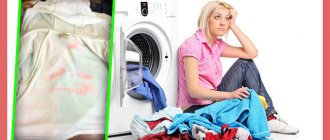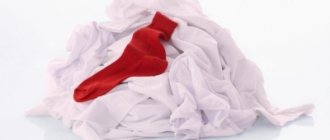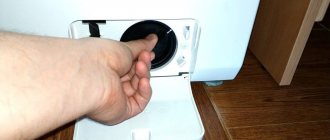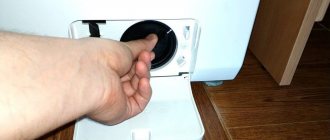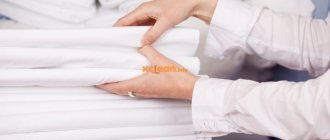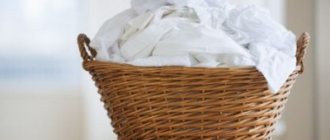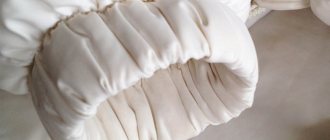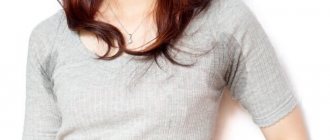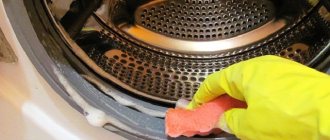If things turn a new color during washing, don’t get upset and throw them away. Indeed, today there are many ways and means to help bleach things that have been dyed during washing without harming the basic color and structure of the fabric.
Such situations occur often, especially among young housewives who are trying to do everything around the house. This is how snow-white shirts with bright socks or handkerchiefs accidentally end up in the same wash, which release dye upon contact with warm water and leave their pigment in the form of streaks and stains on light-colored clothes.
What things are painted most often?
What sheds first:
- new clothes;
- jeans;
- jackets;
- bright things, especially red, orange, green, black, brown and blue;
- synthetics.
What is most susceptible to staining when washing:
- white fabric of any composition;
- natural fabrics;
- anything that was washed with lightly dyed colored clothing.
Crystal white things should not be washed even with light beige, gray, or pink. There is always a risk of slight staining. And especially do not wash white with red and black, even if dark things have never faded before.
Machine washable underwire bra
If you don't know how to properly wash an underwire bra, you'll likely put it in the washing machine with your other clothes. This will inevitably lead to premature deterioration in the quality of the product.
You should wash your underwire bra in the washing machine with the hooks fastened and place it in a special bag. Cases have several purposes:
- straps protect against stretching;
- prevent hooks from wrapping around other clothes;
- prevent deformation and breakage of the bone.
Install a delicate program. If not available, select the lowest temperature.
Emergency recovery
The first thing many housewives do immediately after discovering stains is to put things in the drum again. That's right, try adding more powder or gel, as well as oxygen bleach. An alternative is to rub the wet item with a bar of laundry soap and let it sit for half an hour and then wash it.
We save things depending on the type of fabric
Natural cotton and linen items can withstand hot water, powerful bleach and even boiling. But these radical methods are absolutely not suitable for synthetics and openwork products.
Tip Aggressive spinning in the drum is one of the reasons for quickly washing out paint from fabrics. Set the minimum speed. The higher the friction, the greater the risk of shedding. It is for this reason that matter of different composition and density is sorted.
Natural fabrics
First, repeat the machine wash, but with more powder. Another option is to soak in hot water and bleach. If it doesn’t help, then start boiling. This is the slow heating of a solution with a bleaching component. The procedure lasts no more than half an hour.
Synthetic fabrics
Boiling is absolutely not suitable for synthetics, and even washing in hot water will only worsen the situation. To correct staining, use cool water and a gentle bleach.
Silk, wool, delicate fabrics
Take care of wool, silk and other delicate items in the same way as synthetics. Treat expensive fabrics like cashmere like royalty: wash strictly separately and only according to the instructions on the label.
Chemical bleaching
There are two reasons for the popularity of bleaches. They have excellent disinfecting abilities and are able to remove germs, fungi, and bacteria, preventing their proliferation. Not the last property is the whitening of linen.
"White"
Use Whiteness bleach as your last option. It will keep your bra white and disinfect it. But do not overdo it with the dosage, otherwise the product may damage the fibers of the product.
Important! Remember that Whiteness is harmful and is associated with a wide range of health problems. The product is not suitable for cleaning colored and black items.
Oxygen bleach
Oxygen bleach effectively removes stains of various origins and whitens yellowed laundry.
Whitening process:
- Prepare the bleach solution according to the instructions.
- Soak a white bra in the solution for 30 minutes.
- When cleaning a specific area, wipe it with the solution.
- Wash it. When machine washing, use the bra wash cover.
Expert opinion
Natalya Osadchaya
It is advisable to pre-clean some greasy stains with dishwashing detergent or a special cleaner. The bra can then be washed as usual by adding bleach to the water.
Special equipment
If repeated washing with lots of soap or powder does not work, move on to more powerful measures. Hardware stores are pleased to offer bleaches with universal characteristics. Let's look at the most popular products and categories.
Antilin
This product is suitable for both white and colored items if they are painted with someone else’s shade. The original color is retained. Can be used for both machine and hand washing.
Bleach
A number of manufacturers from Vanish to Synergetic offer bleaches based on oxygen and optical brightening particles.
The obsolete component chlorine is still used. Products containing it are cheap, but their negative effect on materials requires increased care.
Stain remover
An alternative for dyed items is stain remover. You should not bleach pink or beige; instead of paint stains, faded areas will appear. Look for bottles marked “color.”
Powder + bleach
Some powders contain whitening granules. It is very comfortable. You can wash not only dyed items, but also ordinary ones - to prevent and preserve whiteness.
At home, try whitening methods one at a time, do not mix several types of household chemicals at once, wanting to speed up the result. Unexpected reactions are possible, and the clothes will deteriorate completely. Before trying a new product, rinse the test clothing thoroughly.
Household chemicals to help
Industrial products can restore things to their original appearance even in severe cases, but the result will be better if the stains have appeared recently. The following special products will help you get rid of shedding:
- Stain removers;
- Powder with color restoration effect;
- Bleach;
- Air conditioner.
The second product on the list works by containing enzymes that dissolve and create a protective shell. Good reviews on forums about drugs such as Perwoll, Laska, etc.
Bleaching agents are only suitable for white fabrics. They contain chlorine and oxygen, which are gentle on the material. The list of the best includes such chemistry as Chirton, Ace, Bass, etc.
Conditioners are used for rinsing, protecting the color of clothes and making them soft. Stain removers are necessary for cleaning colored and white materials. It is enough to keep the product on the affected area for about an hour and wash.
Popular ones include Silan and Lenore. Complex stains or stains can be dealt with using chemicals such as Eared Nanny, Vanish, etc. Stain removers contain chlorine, enzymes and oxygen, which are suitable for any material.
Important! When choosing a bleach or stain remover, be sure to read the instructions and test the effect on inconspicuous areas.
Traditional methods
Often, improvised products turn out to be no worse than expensive bleaches. The main thing is to apply them on time and in the right concentration. Just follow the recommendations for the type of fabric.
White
We recommend avoiding “Whiteness”, as it weakens the fibers and, if overused, causes grayness and deformation.
The product will come in handy if thick natural fabrics made of cotton, such as sheets, are heavily dyed and cannot be cleaned with anything. This chlorine bleach is used for soaking in cold water. “Whiteness” disinfects fabrics and removes greasy stains - a nice bonus.
How to restore snow-white color:
- Use protective gloves; chlorine corrodes the skin of your hands.
- For 4 l - 1 tbsp. l. "Whiteness." This is a soaking solution and lasts 15 minutes.
- Rinse clothes thoroughly afterwards.
Boric acid
Boric acid will save the most delicate white items if they have become dyed during washing. Take 1 tbsp. l. acid per 2 liters of water.
This is the best way to soak socks, T-shirts, baby clothes and underwear. Boric acid destroys fungus - a useful property for fabrics that cannot be washed in hot water.
Laundry soap + boiling
In the first case, after an unsuccessful wash, we urgently rubbed the entire fabric with a bar. Give laundry soap a second chance if your thick cotton item is damaged:
- Grate the block.
- Pour water into a pan, add soap, stir.
- Place the dyed item in the solution and start heating it slowly.
- Boil over low heat for 20-30 minutes, stirring constantly.
- Let the solution cool slightly and remove the clothes. Hot water pulled the paint out of the fibers; all that was left was to rinse thoroughly.
Vinegar
Now it's time for delicate fabrics. Colorless table vinegar, strengthened with laundry soap, will quickly restore the white color:
- For 5 liters of water - 3 tbsp. l. vinegar and some soap shavings.
- Soak for a convenient time, possibly overnight.
Soda
Prepare the following solution: for every liter of water - 1 tbsp. l. soda Let the item sit in the warm mixture for several hours, and then wash it again, this time without dyeing fabrics.
Turpentine
Treatment with turpentine will prevent new cotton items from fading and losing their brightness. For 1 liter - 10 ml of product. Soak for half an hour. The same solution will be useful if things are painted.
Hydrogen peroxide
Peroxide will save any T-shirt, since, in fact, it is an oxygen bleach:
- For 4 liters of water - a 50 ml bottle of hydrogen peroxide.
- You can add washing powder.
- Soak affected clothing for an hour, then wash.
Tip Peroxide is suitable for boiling: 3 tbsp per pan is enough. l.
Ammonia
For 6 liters of water - 1 tbsp. l. ammonia. Immerse the painted fabric in the solution for half an hour.
Starch
Previously, housewives regularly starched white collars, sheets and other things. If you mix potato starch, lemon juice and a little grated laundry soap, and then treat the stains from the inside out, then after a couple of hours the usual whiteness of the fabric will be restored. The method is suitable for synthetics.
Potassium permangantsovka
The French way to whiten things:
- The solution is only slightly concentrated. A few permanganate crystals are enough for a basin of water so that the water is barely colored.
- Add powder and soak the item.
- Don't forget to rinse. An extra wash won't hurt.
Lemon juice
This citrus is useful not only for colds, but also for emergency treatment of faded items, including delicate items, wool and silk. Simply squeeze the juice out of the fruit and apply it to the stain from the inside out. After 1 hour, rinse, usually this time is enough to remove the paint.
Advice: Lemon juice is replaced with a solution of citric acid - 15 g per glass of water.
What you need to restore color to dyed clothes
Stock up on the items listed below. Perhaps you will find some things in your home arsenal, but others will have to be purchased:
- Ammonia (ammonia solution);
- Vinegar;
- Hydrogen peroxide (perhydrol);
- Soda;
- Salt;
- Lemon acid;
- Potato starch;
- Black tea;
- Black mascara;
- Laundry soap.
Exactly which ingredients from the list you will need depends on what fabrics and colors you will be working with. For bleaching or tinting, different compositions are needed. So before you go shopping, check out the ways to restore faded items.
How to prevent staining
Preventing staining of fabrics is easier than removing stains. This is a truism familiar to every housewife. Especially the one who had to urgently bleach stains from her clothes.
Sorting
This is the basic rule. We sort not only by color (white, light, different colors, black), but also by the composition of the material. Natural linen with synthetics cannot be washed.
We wash new items separately
Introduce new clothes to water and powder as carefully as possible and separately from other things: we don’t know how the fabric will behave. The examination can be carried out in a separate small area. Wet the edge of the fabric with warm water and see what happens.
Temperature
Even items washed several times can suddenly fade due to hot water. It's simple: the higher the washing temperature, the easier the paint particles are washed out.
Wash certain items by hand
Inspect the details of the clothing carefully: even stripes, pocket lining or collars may fade, leaving stains on lighter areas. Treat such items in cold water and quickly; do not soak them for a long time.
Note color fixing tricks: vinegar and salt solution for pre-soaking. Special washing conditioners will help restore the brightness and color of dyed clothes.
Tip How to wash a black dress with a white collar: soak the item briefly in soapy water, wash, rinse and wring out. Then lay it out on a flat surface and apply the bleach solution strictly to the collar. After 15-20 minutes, rinse the dress completely again and send to dry.
Lace products
Expensive lace and silk lingerie looks beautiful and seductive. However, happy owners carefully choose how to bleach their lace underwear so as not to deform the fabric or lose the shape of the lace. Two products that you can find in the kitchen are suitable for this.
Vinegar solution
- Add one glass of 9% vinegar to 2 liters of warm water.
- Soak the laundry in the solution overnight.
- Wash as usual.
Soda-salt solution
- Dissolve two tablespoons of salt and soda in cold or warm water.
- Stir thoroughly so that no grains remain in the water.
- Soak the laundry.
- Leave for two to three hours.
- Rinse and wash items as usual.
The vinegar solution will do an excellent job of bleaching silk and satin fabrics, making the white color more saturated, and getting rid of stains. A saline solution is suitable for bleaching a guipure bra. Guipure is made from thin natural threads mixed with synthetic fibers, so the water temperature should not exceed 40°C.
Bleaching, even with natural means, always has a strong effect on the fabric. Therefore, in order not to rack your brains over how to bleach your underwear, you should follow the rules for wearing, washing and caring for your bra and panties. It is better not to wear white underwear under dark clothes and wait until the deodorant has completely dried before getting dressed. Linen washed on time and in compliance with all recommendations will retain its color and shape for a long time.
